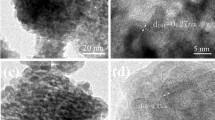Abstract
The fine crystal structure of hematite samples used for preparing potassium promoted iron oxide catalysts of dehydrogenation is studied via X-ray diffraction and scanning electron microscopy. α-Fe2O3 samples are synthesized under non-equilibrium conditions from several precursors in different regimes of thermolysis. The most important characteristic of hematite that causes the activity and selectivity of a hematite-based catalyst is its fine crystal structure (FCS). The fine crystal structure of hematite predetermines the phase composition of the catalyst. The fine crystal structure of hematite forms during its synthesis and is determined by the nature of the precursor, the temperature of synthesis, the temperature gradient, and the rate of the removal of gaseous thermolysis products. The highest activity is displayed by the catalyst prepared on the basis of hematite with mosaic blocks 70–90 nm in size and a minimum SF concentration caused by half and quaternary dislocations. Such hematite was synthesized via the thermolysis of iron sulfate at 950 K under fluidized bed and low temperature gradient conditions. Hematite from iron carbonate is not recommended for use in synthesizing a catalyst due to the high concentration of low-temperature SFs, which result in the formation of catalytically low-active potassium β-polyferrite.




Similar content being viewed by others
REFERENCES
Gobara, H.M., Aboutaleb, W.A., Hashem, K.M., Hassan, S.A., and Henein, S.A., J. Mater. Sci., 2017, vol. 52, no. 1, pp. 550–568. https://doi.org/10.1007/s10853-016-0353-2
Mousavi, S.E., Younesi, H., Bahramifar, N., Tamunaidu, P., and Karimi-Male, H., Chemosphere, 2022, vol. 297, article no. 133992. https://doi.org/10.1016/j.chemosphere.2022.133992
Bugaeva, A.Yu., Loukhina, I.V., Kazakova, E.G., Nazarova, L.Yu., and Ryabkov, Yu.I., Russ. J. Appl. Chem., 2019, vol. 92, no. 10, pp. 1366–1376. https://doi.org/10.1134/S1070427219100069
Lamberov, A.A., Gil’manov, Kh.Kh., Dement’eva, O.V., Shatokhina, E.V., Nurgaliev, D.K., and Yasonov, P.G., Katal. Prom-sti, 2008, no. 2, pp. 42–49.
Il'in, A.A., Izv. Vyssh. Uchebn. Zaved., Khim. Khim. Tekhnol., 2019, vol. 62, no. 5, pp. 62–70.
Lamberov, A.A., Gilmanov, Kh.Kh., Dement’eva, O.V., and Kuz’mina, E.V., Catal. Ind., 2012, vol. 4, no. 4, pp. 308–316. https://doi.org/10.1134/S2070050412040113
Yatsenko, D.A., Pakharukova, V.P., Tsybulya, S.V., Matvienko, A.A., and Sidel’nikov, A.A., J. Struct. Chem., 2012, vol. 53, no. 3, pp. 548–556. https://doi.org/10.1134/S0022476612030195
Fadeeva, V.I., Itogi Nauki Tekh., Ser.: Khim. Termodin. Ravnovesiya, 1984, vol. 6, pp. 44–76.
Dvoretskii, N.V., Stepanov, E.G., Sudzilovskaya, T.N., and Kotel’nikov, G.R., Kinet. Katal., 1990, vol. 31, no. 4, pp. 939–944.
Dvoretskii, N.V., Stepanov, E.G., Sudzilovskaya, T.N., Kotel’nikov, G.R., and Yun, V.V., Izv. Akad. Nauk SSSR, Neorg. Mater., 1989, vol. 25, no. 2, pp. 284–288.
Dvoretskii, N.V., Anikanova, L.G., and Malysheva, Z.G., Izv. Vyssh. Uchebn. Zaved., Khim. Khim. Tekhnol., 2018, vol. 61, no. 6, pp. 61–68.
Dvoretskii, N.V. and Anikanova, L.G., Izv. Vyssh. Uchebn. Zaved., Khim. Khim. Tekhnol., 2002, vol. 45, no. 2, pp. 147–148.
Lamberov, A.A. and Gil’manov, Kh.Kh., Modernizatsiya katalizatorov i tekhnologii sinteza izoprena na OAO “Nizhnekamskneftekhim” (Modernization of Isoprene Synthesis Catalysts and Technology at JSC “Niznekamskneftekhim”), Kazan: KFU, 2012.
Fadeeva, V.I. and Panchenko, L.A., Izv. Akad. Nauk SSSR, Neorg. Mater., 1982, vol. 18, no. 8, pp. 1399–1401.
Fadeeva, V.I., Panchenko, L.A., Winkel, A.P., et al., Zavod. Lab., 1983, vol. 49, no. 4, pp. 57–58.
Anikanova, L.G. and Dvoretskii, N.V., Catal. Ind., 2013, vol. 5, no. 1, pp. 74–79. https://doi.org/10.1134/S2070050412040022
Dvoretskii, N.V. and Anikanova, L.G., Izv. Vyssh. Uchebn. Zaved., Khim. Khim. Tekhnol., 2002, vol. 45, no. 7, pp. 50–52.
Lopatina, M.M., Kosheleva, K.A., Khanmurzina, E.A., D’yakonov, V.A., and Nefedova, N.V., Usp. Khim. Khim. Tekhnol., 2020, vol. 34, no. 4, pp. 34–39.
Yamaguchi, T. and Takahashi, T., J. Am. Ceram. Soc., 1982, vol. 65, no. 6, pp. c83. https://doi.org/10.1111/j.1151-2916.1982.tb10455.x
Levin, B.E., Tret’yakov, Yu.D., and Letyuk, L.M., Fiziko-khimicheskie osnovy polucheniya, svoistva i primenenie ferritov (Physicochemical Foundations of Synthesis, Properties, and Application of Ferrites), Moscow: Metallurgiya, 1979.
Mozhaev, A.P., Oleinikov, N.N., Pershin, V.I., and Tret’yakov, Yu.D., Izv. Akad. Nauk SSSR, Neorg. Mater., 1977, vol. 13, no. 10, pp. 1856–1860.
Author information
Authors and Affiliations
Corresponding author
Additional information
Translated by E. Glushachenkova
Rights and permissions
About this article
Cite this article
Dvoretskaya, A.N., Anikanova, L.G. & Dvoretskii, N.V. Effect of the Precursor and Synthesis Regime on the Properties of Hematite for Preparing Promoted Iron Oxide Catalysts. Catal. Ind. 15, 144–151 (2023). https://doi.org/10.1134/S2070050423020046
Received:
Revised:
Accepted:
Published:
Issue Date:
DOI: https://doi.org/10.1134/S2070050423020046




